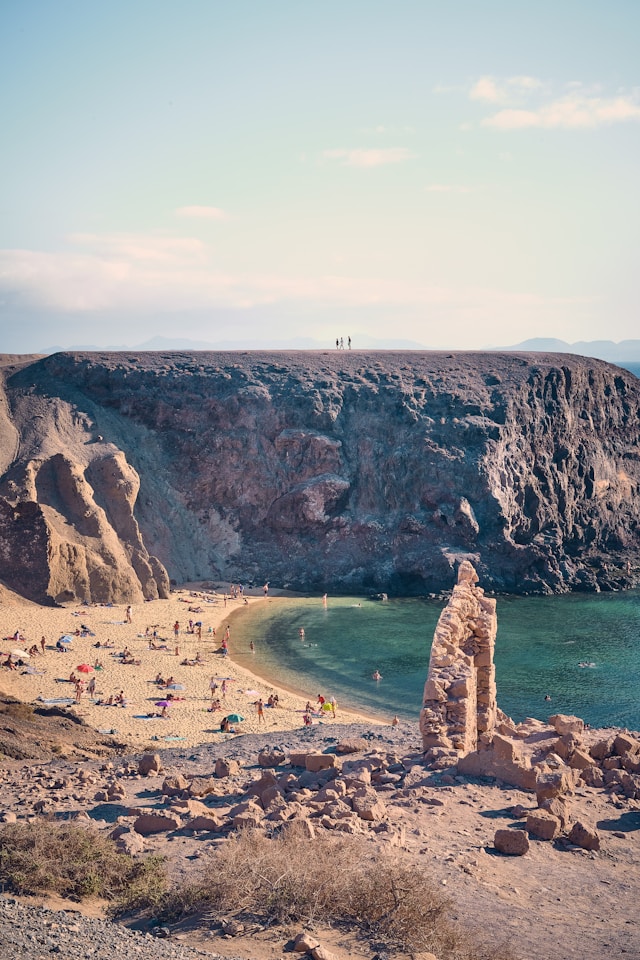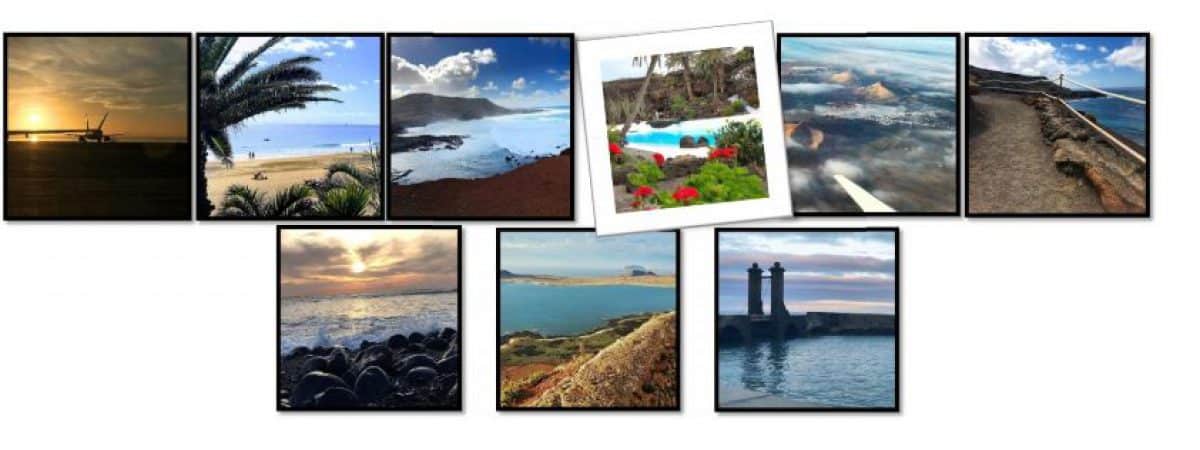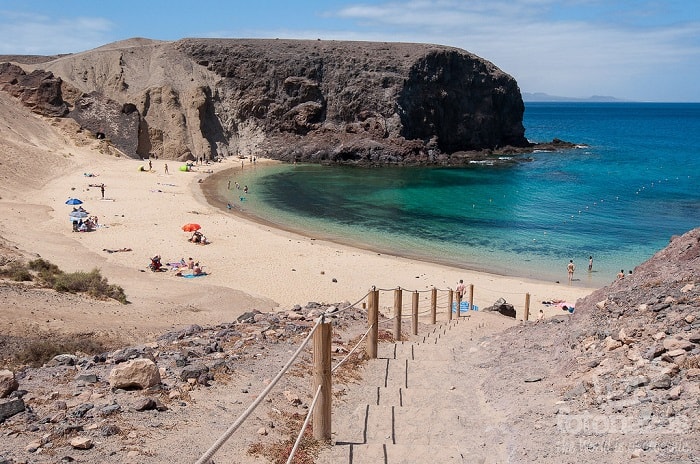This post is also available in:  Español (Spanish)
Español (Spanish)
Papagayo Beach is located in the southern part of the island, with emerald waters and fine sand. Here on First Minute Transfer, we highlight this and other reasons why this beach is so popular both on the island and across the country. Keep reading and take notes for your next trip!
Papagayo Beach: Protected by Los Ajaches
In the southernmost area of Lanzarote lies the Los Ajaches Natural Monument, also known as Punta Papagayo. This is an untouched area where human intervention is minimal. For this reason, visiting it feels like stepping into one of the island’s most natural and pristine territories.
Here, you’ll find more of the volcanic landscapes that define Lanzarote, along with a series of stunning beaches that rank among the best on the island. Because of the area’s protected status, the only signs of human activity you’ll encounter are the car park, two small beach bars, and a campsite.
Within this natural park lies Papagayo Beach, undoubtedly one of the most popular beaches on the island, especially for families. However, there are other sandy stretches in the area, and you can walk from one to another. The views are spectacular, so take your time to enjoy the rugged landscape blending beautifully with the emerald hues of the water.
In addition to Papagayo Beach, the park is home to six other coves and beaches. These include Puerto Muelas, Caleta del Congrio, Playa de la Acera, Playa del Pozo, Playa Mujeres, and Calentón de San Marcial. Despite being surrounded by cliffs, these beaches feature fine sand, ensuring your stay is both comfortable and relaxing.
If you’re planning excursions in Lanzarote, Punta Papagayo should be a key stop on your itinerary.
A Complete Guide to Papagayo Beach in Lanzarote
A Small, Charming Beach
Papagayo Beach is a small cove, measuring just 120 metres in length and 15 metres in average width. It is nestled within a shell-shaped inlet, protected by cliffs that shield it from the wind. This makes it a calm, peaceful spot with minimal waves, and one of the key reasons to visit Lanzarote.
Crystal-Clear Waters and Golden Sand
The feeling of being in an unspoiled environment, the transparent waters with an intense emerald tone, and the gentle waves are the main attractions of Papagayo Beach. Although it is one of the most popular destinations in Lanzarote, you can still enjoy it without feeling overcrowded.
Thanks to these unique features, it was voted one of the best beaches in Spain in 2019, earning the top spot. Papagayo Beach was named the best beach in Spain by readers of Condé Nast Traveler.
From this spot, you can also enjoy views of Isla de Lobos and Fuerteventura. Just a few metres away, perched on the cliffs, you’ll find the Cala Papagayo Beach Bar, where you can sit under a sunshade, enjoy a meal or a drink, and experience one of the most stunning sunsets on the island.
A Protected Natural Environment
As mentioned earlier, Papagayo Beach is located within the Los Ajaches Natural Park, an area of significant ecological value where both the land and marine ecosystems are carefully protected.
The beach itself has remained untouched. You won’t find restaurants, sun loungers, or umbrellas here. As such, it’s essential to come prepared with enough water, food, and sunscreen.
Because this is a protected environment, it’s crucial to follow the rules. For instance, avoid lighting fires, camping, or removing natural elements. If you’re planning to snorkel or dive, observe the marine life from a distance and do not disturb it.
Additionally, remember to take all your rubbish with you and dispose of it in the designated bins before leaving the beach.
Activities for everyone
Papagayo Beach has become one of the most popular spots for families. Its calm waters are perfect for children to play and enjoy a safe swim. Thanks to its size and the absence of large crowds, it’s easy to keep an eye on them. However, during peak season, the number of visitors does increase.
The surrounding environment is also ideal for snorkelling and diving, particularly for beginners. Swimmers often enjoy the marine life at Papagayo Beach, where you can observe a variety of fish, starfish, and other sea creatures.
For those who enjoy hiking and trekking, there are trails near Papagayo Beach that allow you to explore the coast and the island’s interior.
In the past, Papagayo Beach was known as a nudist destination. However, in recent years, most naturists now prefer nearby beaches such as Puerto Muelas and Caleta del Congrio.
You can also simply sunbathe, relax on the fine sand, have a picnic, or watch the sunset for a more laid-back experience.
How to Get to Papagayo Beach
Papagayo Beach is conveniently located, not too far from the nearest towns. From Playa Blanca, take the road towards the village of Femés. Along the way, you’ll find a dirt track that leads to the Los Ajaches Natural Monument.
After driving along this route, you’ll reach a parking area. The fee is €3 per vehicle, but pedestrians and cyclists can enter for free. From the car park, it’s just a short walk to Papagayo Beach or any of the nearby coves.
Another option is to take a taxi from anywhere on the island. While more comfortable, this option is also more expensive.
Although there is no direct public transport to Papagayo Beach, you can take a bus to Playa Blanca, the nearest town, and then either walk (around 5 km) or take a taxi to the beach.
A Different Way to Enjoy Papagayo Beach
If you’d prefer not to travel by land, you can also experience Papagayo Beach from the sea. Boat trips allow you to sail past the cove and admire it from a different perspective. Once anchored near the beach, you can swim, snorkel, or even kayak.
If you do travel by land but wish to stay in the natural park instead of a nearby town, you can book a spot at the campsite. This allows you to immerse yourself in the tranquillity of the surroundings and spend more time exploring the beaches in the area.
Services and Facilities at Papagayo Beach
As previously mentioned, Papagayo Beach doesn’t offer services like umbrella or chair rentals, nor are there any large beach bars. However, there is parking available, rubbish bins to help keep the area clean, and accessibility for visitors with reduced mobility.
If you’re looking for shade, the cliffs surrounding the beach provide natural shelter during the hottest parts of the day.
Tips for Visitors to Papagayo Beach
- Best time to visit: Spring and autumn, particularly from April to June and September to December, are the best months to visit. Temperatures are more pleasant, and there are fewer tourists than in summer.
- Follow local regulations: Remember that you are visiting a protected area, so respect the local flora and fauna. Camping is not allowed.
- Arrive early: Parking is limited, so it’s a good idea to arrive early to secure a spot.
- Take care of the environment: Use the bins provided to dispose of your rubbish.
- Protect yourself from the sun: Bring high-factor sunscreen, a hat, and sunglasses, and make sure to stay hydrated.

Spain’s Best Beaches
In 2019, readers of Condé Nast Traveler voted Papagayo Beach as one of the best in Spain. Here are the full rankings:
- Papagayo Beach in Lanzarote. Located in a protected natural environment, it is one of the must-visit spots when travelling to the island of volcanoes.
- Cala Cortina in Murcia. A paradise with turquoise waters and white sand, offering all the services you might need.
- Torimbia Beach in Asturias. A vast stretch of white sand. Access is by foot, but the journey offers stunning views. It includes a nudist area.
- Valdevaqueros Beach in Andalusia. A 4-kilometre-long coastline in Tarifa, Cádiz, with intensely blue waters. One of the best spots for water sports.
- Pechón Beach in Cantabria. Surrounded by rocky formations, its unique feature is the formation of two beaches, one opposite the other, during low tide.
- Figueiras Beach in Galicia. Situated on the Cíes Islands, it is a small beach surrounded by pine trees, with fine white sand and turquoise waters. Nudism is permitted.
- Es Racó de s’Alga Beach in the Balearic Islands. A nudist beach located on Espalmador Island, accessible only by boat.
- La Concha Beach in the Basque Country. The 1,350-metre-long La Concha offers a picture-perfect setting. It is the most iconic beach in San Sebastián.
- North Beach in the Valencian Community. A 5-kilometre-long beach that ends at the Papa Luna Castle.
- Sa Futadera Cove in Catalonia. Found in Tossa de Mar, it remains untouched, with a length of 100 metres and an average width of 10 metres.
Papagayo Beach stands out for its unique, tranquil environment, far from the hustle and bustle. Don’t miss it on your next visit to Lanzarote! Contact us to start planning your trip today.
This post is also available in:  Español (Spanish)
Español (Spanish)

